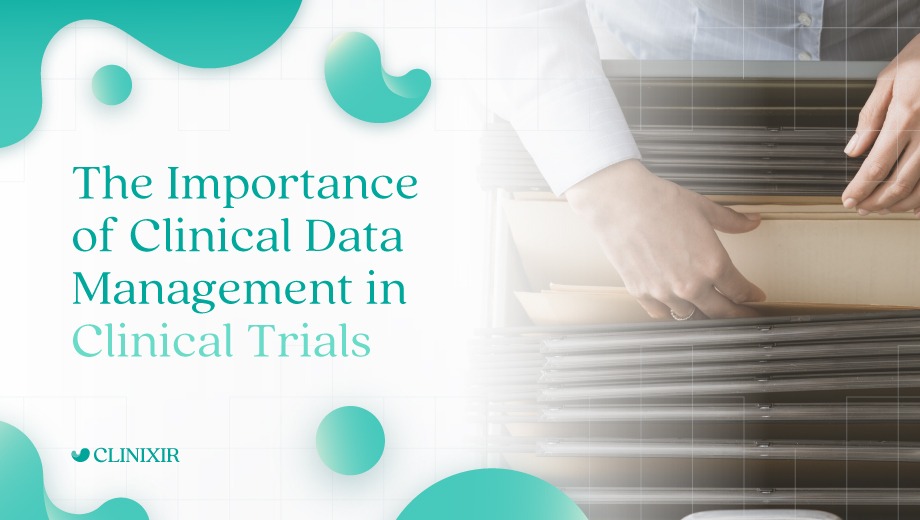Clinical data management (CDM) plays a key role in the success of every trial, as it directly affects treatment development decisions – and therefore the health of patients. That’s why regulatory bodies maintain strict standards and guidelines when it comes to clinical data. Data which is harnessed correctly can facilitate the development of life-changing treatments.
This article will explore what CDM is, the processes it entails, and some foundational regulations and guidelines that maximize its effectiveness.
What is CDM and why is it important?
Broadly speaking, clinical data management is a set of practices that handle all information generated during clinical research. It aims to ensure data quality, integrity, and compliance with internal protocols and regulations.
CDM plays a vital role in evaluating the safety and effectiveness of treatments (e.g. pharmaceuticals and medical devices). Proper CDM ensures that the data collected is comprehensive and can be used for statistical analysis, is formatted appropriately, and is transferable while truthfully representing the trial data collected.
If handled properly, it can expedite the development of a treatment, while assuring data quality and reducing costs overall. That’s why effective CDM often represents one of the most valuable assets of pharmaceutical companies.
Because data is so central to the core function of these companies, it is absolutely vital that clinical data collected and analyzed are of high quality and handled with integrity. Understanding the process of CDM can clarify both the value it provides and the effort needed to preserve its effectiveness. However, due to the complex details involved, this article will only cover the basic elements in brief.
Case Report Form (CRF) design
The initial stage of developing proper CDM is creating a Case Report Form (CRF) design. The CRF will guide all future data collection for the trial and beyond. It is therefore critical that this stage is well thought-out, as it will set the stage for all subsequent steps. Any deficits in the CRF will make completing the trial with a usable data set far more difficult.
Examples of things to be considered at this stage include creating appropriate processes for eligibility screening, follow-up visit protocols, development of adverse effects (AE) forms, lab test forms, evaluations, and compilations of medical histories, along with other related concerns. Given its critical place in developing a successful trial, as well as the need for real-time adjustments alongside the preservation of data integrity, electronic CRFs have been gradually replacing paper-based analogs for faster data collection and better quality of information.
Data Management Plan (DMP)
The next step is to create a data management plan (DMP) which details how data will be handled based on how the study will be run. This plan covers the activities to be performed during the trial, including how to manage master file maintenance, database design, data collection protocols, data entry and storage, privacy issues, data review and discrepancy management, data extraction options, and overall database integrity. The goal here is to standardize these procedures while ensuring that all CDM participants understand the stated objectives and goals of the CDM.
Data Validation Manual (DVM)
Next is the development of a data validation manual (DVM) which covers the procedures to edit and address potential discrepancies in data collection. These edit check systems help the site monitors and CDM staff to identify and address any potential data discrepancies during the collection, while also outlining procedures for the cleaning of the overall data set.
Often referred to as discrepancy management or query resolution, these steps serve as a vital mechanism to investigate, address, and mitigate discrepancies for a successful trial. The DVM also ensures that timelines are kept, data points are solid and actionable, and raw data can be exported properly as needed. If and when data-related changes need to be made, they need to follow protocols set in the DVM to ensure data integrity across the trial. The DVM also establishes systems to regularly review data generated throughout the trial, allowing any issues to be resolved promptly so that the trial can run smoothly.
Data coding
Related to and building upon the DVM is the need for strong data coding. This feature allows for standardization when it comes time for the data to be analyzed and reviewed. The need for uniform coding in regards to adverse events, medical histories, concomitant medications, and related issues is paramount. The importance of this uniformity is especially acute when dealing with trials involving multiple sites and investigators, as it enables the accurate reporting of information across various locations.
Database lock (study closeout)
The final step is the study closeout, often referred to as the database lock. This stage refers to the point when all data management activities have been completed and finalized. It is important to ensure that the data is clean and has not been manipulated, to ensure accurate results post-trial. Having a pre-lock checklist is imperative to ensure that nothing has been missed or overlooked, and that all the collected data is consistent and conforms to the original guidelines set up in the DMP.
At every step of the clinical trial, it is critical that common regulations, guidelines, and standards are enforced. These can include general criteria such as the Code of Federal Regulations (CFR), 21 CFR Part 11, maintenance of Good Clinical Practice (GCP) guidelines, and adherence to the Clinical Data Interchange Standards Consortium (CDISC). In addition to these general regulations, each trial will need to adhere to trial-specific regulations to ensure that all data collected is done ethically, professionally, and efficiently – while maintaining patient safety above all else.
Clinixir can help your organization with any or all of these steps, to ensure a robust and usable data set upon completion of your trials. We are fully compliant with the US FDA’s 21 CFR Part 11 requirements, and our data management systems are specially designed to assist in e-clinical systems. Contact us to learn more about how we can assist you.



